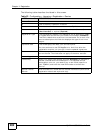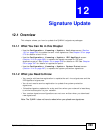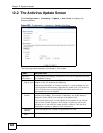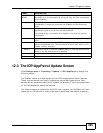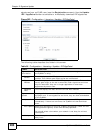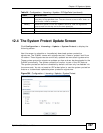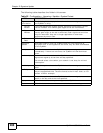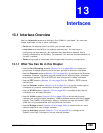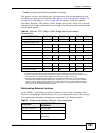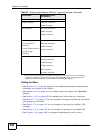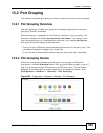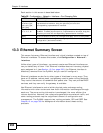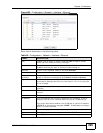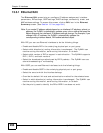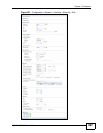
Chapter 13 Interfaces
ZyWALL USG 300 User’s Guide
290
•Use the Virtual Interface screen (Section 13.11 on page 356) to create virtual
interfaces on top of Ethernet interfaces to tell the ZyWALL where to route
packets. You can create virtual Ethernet interfaces, virtual VLAN interfaces, and
virtual bridge interfaces.
•Use the Trunks screens (Chapter 14 on page 363) to configure load balancing.
13.1.2 What You Need to Know
Interface Characteristics
Interfaces generally have the following characteristics (although not all
characteristics apply to each type of interface).
• An interface is a logical entity through which (layer-3) packets pass.
• An interface is bound to a physical port or another interface.
• Many interfaces can share the same physical port.
• An interface belongs to at most one zone.
• Many interfaces can belong to the same zone.
• Layer-3 virtualization (IP alias, for example) is a kind of interface.
Types of Interfaces
You can create several types of interfaces in the ZyWALL.
• Port groups create a hardware connection between physical ports at the layer-
2 (data link, MAC address) level.
• Ethernet interfaces are the foundation for defining other interfaces and
network policies. RIP and OSPF are also configured in these interfaces.
• VLAN interfaces receive and send tagged frames. The ZyWALL automatically
adds or removes the tags as needed. Each VLAN can only be associated with
one Ethernet interface.
• Bridge interfaces create a software connection between Ethernet or VLAN
interfaces at the layer-2 (data link, MAC address) level. Unlike port groups,
bridge interfaces can take advantage of some security features in the ZyWALL.
You can also assign an IP address and subnet mask to the bridge.
• PPP interfaces support Point-to-Point Protocols (PPP). ISP accounts are
required for PPPoE/PPTP interfaces.
• Cellular interfaces are for 3G WAN connections via a connected 3G device.
• Virtual interfaces provide additional routing information in the ZyWALL. There
are three types: virtual Ethernet interfaces, virtual VLAN interfaces, and
virtual bridge interfaces.
•The auxiliary interface, along with an external modem, provides an interface
the ZyWALL can use to dial out. This interface can be used as a backup WAN
interface, for example. The auxiliary interface controls the AUX port.



